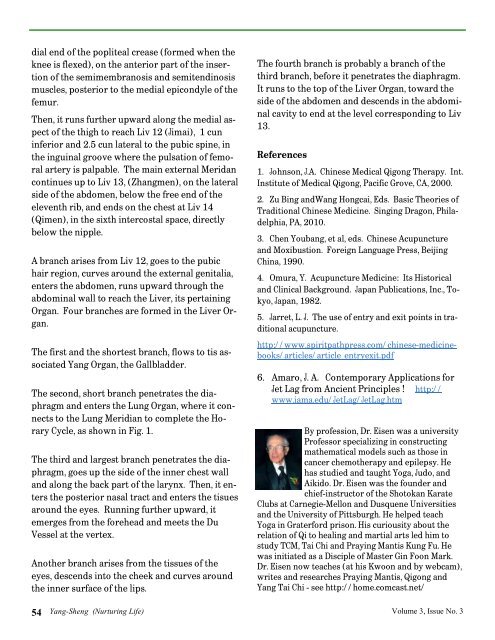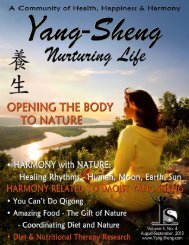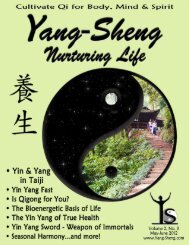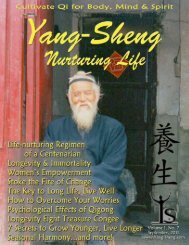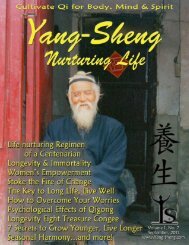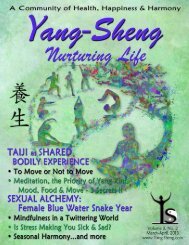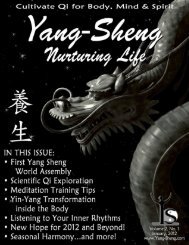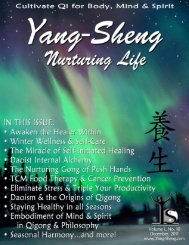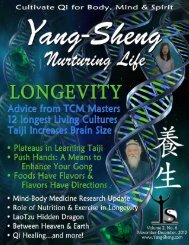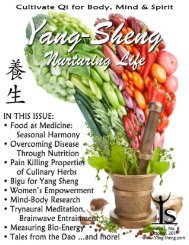dial end of the popliteal cre<strong>as</strong>e (formed when theknee is flexed), on the anterior part of the insertionof the semimembranosis and semitendinosismuscles, posterior <strong>to</strong> the medial epicondyle of thefemur.Then, it runs further upward along the medial <strong>as</strong>pec<strong>to</strong>f the thigh <strong>to</strong> reach Liv 12 (Jimai), 1 cuninferior and 2.5 cun lateral <strong>to</strong> the pubic spine, inthe inguinal groove where the pulsation of femoralartery is palpable. The main external Meridancontinues up <strong>to</strong> Liv 13, (Zhangmen), on the lateralside of the abdomen, below the free end of theeleventh rib, and ends on the chest at Liv 14(Qimen), in the sixth intercostal space, directlybelow the nipple.A branch arises from Liv 12, goes <strong>to</strong> the pubichair region, curves around the external genitalia,enters the abdomen, runs upward through theabdominal wall <strong>to</strong> reach the Liver, its pertainingOrgan. Four branches are formed in the Liver Organ.The first and the shortest branch, flows <strong>to</strong> tis <strong>as</strong>sociated<strong>Yang</strong> Organ, the Gallbladder.The second, short branch penetrates the diaphragmand enters the Lung Organ, where it connects<strong>to</strong> the Lung Meridian <strong>to</strong> complete the HoraryCycle, <strong>as</strong> shown in Fig. 1.The third and largest branch penetrates the diaphragm,goes up the side of the inner chest walland along the back part of the larynx. Then, it entersthe posterior n<strong>as</strong>al tract and enters the tisuesaround the eyes. Running further upward, itemerges from the forehead and meets the DuVessel at the vertex.Another branch arises from the tissues of theeyes, descends in<strong>to</strong> the cheek and curves aroundthe inner surface of the lips.The fourth branch is probably a branch of thethird branch, before it penetrates the diaphragm.It runs <strong>to</strong> the <strong>to</strong>p of the Liver Organ, <strong>to</strong>ward theside of the abdomen and descends in the abdominalcavity <strong>to</strong> end at the level corresponding <strong>to</strong> Liv13.References1. Johnson, J.A. Chinese Medical Qigong Therapy. Int.Institute of Medical Qigong, Pacific Grove, CA, 2000.2. Zu Bing andWang Hongcai, Eds. B<strong>as</strong>ic Theories ofTraditional Chinese Medicine. Singing Dragon, Philadelphia,PA, 2010.3. Chen Youbang, et al, eds. Chinese Acupunctureand Moxibustion. Foreign Language Press, BeijingChina, 1990.4. Omura, Y. Acupuncture Medicine: Its His<strong>to</strong>ricaland Clinical Background. Japan Publications, Inc., Tokyo,Japan, 1982.5. Jarret, L. J. The use of entry and exit points in traditionalacupuncture.http://www.spiritpathpress.com/chinese-medicinebooks/articles/article_entryexit.pdf6. Amaro, J. A. Contemporary Applications forJet Lag from Ancient Principles ! http://www.iama.edu/JetLag/JetLag.htmBy profession, Dr. Eisen w<strong>as</strong> a universityProfessor specializing in constructingmathematical models such <strong>as</strong> those incancer chemotherapy and epilepsy. Heh<strong>as</strong> studied and taught Yoga, Judo, andAikido. Dr. Eisen w<strong>as</strong> the founder andchief-instruc<strong>to</strong>r of the Sho<strong>to</strong>kan KarateClubs at Carnegie-Mellon and Dusquene Universitiesand the University of Pittsburgh. He helped teachYoga in Graterford prison. His curiousity about therelation of Qi <strong>to</strong> healing and martial arts led him <strong>to</strong>study TCM, Tai Chi and Praying Mantis Kung Fu. Hew<strong>as</strong> initiated <strong>as</strong> a Disciple of M<strong>as</strong>ter Gin Foon Mark.Dr. Eisen now teaches (at his Kwoon and by webcam),writes and researches Praying Mantis, Qigong and<strong>Yang</strong> Tai Chi - see http://home.comc<strong>as</strong>t.net/54 <strong>Yang</strong>-<strong>Sheng</strong> (Nurturing Life) Volume 3, Issue No. 3
Se<strong>as</strong>onal Harmony 季 节 的 和 谐By Ell<strong>as</strong>ara KlingDiet Therapy is one of the healing modalitiesof Chinese medicine. Diet Therapy isapplied not only <strong>to</strong> alleviate ailments, but isutilized for day-<strong>to</strong>-day living. Choosing foodsthat are fresh, unadulterated, follow the patternsof nature, and are appropriate for yourindividual state at that time, are b<strong>as</strong>ic generalcriteria for everyone at all times. Thechoice of foods for supporting one’s healthusing the principles of Chinese medicine neednot be exotic, nor cost a great deal. Rather,local, se<strong>as</strong>onal foods are utilized <strong>to</strong> addressout of balance conditions, and/or <strong>to</strong> reinforce/augmentthe health that one h<strong>as</strong> obtained.It h<strong>as</strong> long been unders<strong>to</strong>od by Chinesemedicine that the correct daily diet canprevent dis-e<strong>as</strong>e, prolong life, strengthen thebody/mind.Diet Therapy utilizes the principles of yin/yang; hot/cold; dry/damp; calming/stimulating; internal/external; color, t<strong>as</strong>te;relationship <strong>to</strong> the organ systems; the fiveelements; cooking techniques; and muchmore. Even though that seems <strong>to</strong> be a complexlist, it is possible <strong>to</strong> incorporate thismethod of considering food in<strong>to</strong> one’s dailylife with a little attention, practice, someguidance, and by following one’s intuition.Five Element Theory is an excellent place <strong>to</strong>start. For a person who is practicing somemethod of energy cultivation (qigong/taiji/yoga/meditation, for example) or receivingtreatments from a TCM doc<strong>to</strong>r or acupuncturist,then paying attention <strong>to</strong> diet can be ofsignificant support <strong>to</strong> these activities, and canbe viewed <strong>as</strong> an extension of them. Viewingfood from the framework of Five ElementTheory is quite different than the usual westernfood lists. Foods are categorized by se<strong>as</strong>on,t<strong>as</strong>te and flavor along with the organsystem that they support. Foods are meant<strong>to</strong> be appetizing through aroma, visually andt<strong>as</strong>te. Preferably, foods are combined indishes <strong>to</strong> enhance each other and help <strong>to</strong>bring about greater health balance. In theseways, even simple meals can add healthbenefit.Consider these ide<strong>as</strong>: Each item we ingesth<strong>as</strong> its own level of life force available <strong>to</strong>us - clearly, the fresher the food, the greaterthe vibrant energy. Each food item also h<strong>as</strong>its own distinct message within its energypattern. It h<strong>as</strong> its own level of consciousness.When we eat some food, we are literally takingin<strong>to</strong> ourselves a form of energy and incorporatingthat energy in<strong>to</strong> the fabric of ourphysical body. From this point of view, everytime we eat it is potentially an act of healing.We give our body/mind/spirit powerful messagesthrough the choices that we make regardingour diet. What would it be like foryou <strong>to</strong> choose your foods for just one daykeeping in mind this idea? How would thatchange your choices? What changes wouldyou make? How would that affect how youfeel? Perhaps, you would like <strong>to</strong> challengeJune-July 2013 <strong>Yang</strong>-<strong>Sheng</strong> (Nurturing Life) 55
- Page 1 and 2:
Cover should go hereDraft for Comme
- Page 3 and 4: Volume 3, No. 3 www.Yang-Sheng.com
- Page 8 and 9: is to smile from the heart, mind, b
- Page 10 and 11: You’ll start with a pill for bloo
- Page 12 and 13: May;44(5):1360-8. By Threapleton DE
- Page 14 and 15: cancer in the Health Professionals
- Page 16 and 17: decrease in BMI of 8% was the thres
- Page 18 and 19: Ancient Wisdom, Modern Kitchen 古
- Page 20 and 21: From The Doctor 医 生 之 窗Rais
- Page 22 and 23: way, make your food come alive in t
- Page 24 and 25: Meditation in Motion 动 中 冥
- Page 26 and 27: try shows that “Chronic “lifest
- Page 28 and 29: far from ideal: “I estimate I spe
- Page 30 and 31: neered the concept of self-care by
- Page 32 and 33: Book Review 书 评Book Review: Hea
- Page 34 and 35: more awakened and real to you if yo
- Page 36 and 37: Daoist Internal Alchemy 道 家 内
- Page 38 and 39: Qi Cultivation and Dao 炼 气 与
- Page 40 and 41: etween physician and patient, betwe
- Page 42 and 43: neutralize, and transform unhealthy
- Page 44 and 45: make a difference in outcomes. Chap
- Page 46 and 47: dary Yang Cheng Fu, mentioned the f
- Page 48 and 49: the senior students, a disciple of
- Page 50 and 51: Scientific Qi Exploration 气 的
- Page 52 and 53: flexor carpi radialis muscles, endi
- Page 56 and 57: yourself.This year’s Building Bri
- Page 58 and 59: ¼ cup goji berries2-3 fresh mint l
- Page 60 and 61: from the plant's air channels. Lotu
- Page 62 and 63: Yang-Sheng Needs Your Financial Sup


